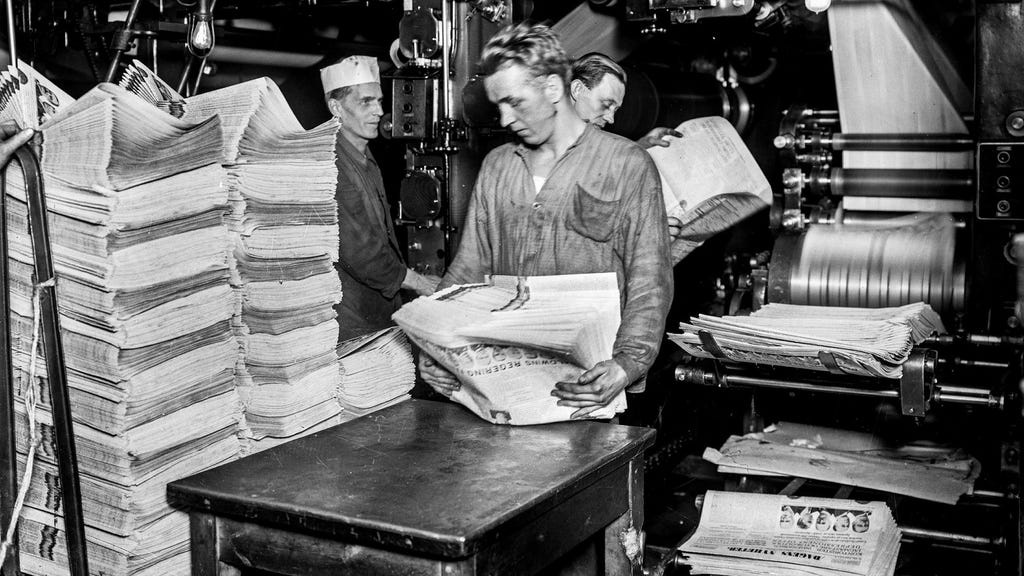The summer of 1963 marked a fleeting, albeit memorable, foray into the world of newspapers for the author. Eager to embark on this new venture, sleep was sacrificed for a 4:00 AM arrival at a distribution hub on Surbrunnsgatan, adjacent to the Johannes police station. The air was thick with the intoxicating aroma of freshly printed newspapers, recently delivered from the printing presses in Klara. The scene buzzed with experienced workers efficiently carrying out their tasks, guided by a supervisor who allocated designated delivery routes, or ”tracts”, encompassing specific building entrances. However, the author’s anticipated contribution was abruptly curtailed. As the morning wore on, the stacks of newspapers dwindled, leaving only the author and the supervisor. With no papers left to distribute, the author was dismissed, instructed to return the following day. This brief encounter highlighted the author’s nocturnal nature, suggesting a better fit for work during the later hours of the day.
This realization led to a subsequent role as a ”leveler” at Stockholms-Tidningen, situated in the same building as Aftonbladet at the corner of Vattugatan and Klara södra kyrkogata. The building’s antique wall clock, a silent witness to countless deadlines met and missed, still hangs in its original place. The leveling team, composed entirely of men, worked alongside a conveyor belt carrying freshly printed newspapers from the press below. Every fiftieth newspaper protruded slightly, signaling the levelers to lift a stack of fifty and transfer them to another conveyor belt, where they were bundled for transport to the loading dock and waiting delivery trucks. Shifts were unpredictable, starting at either 10:00 PM or 1:00 AM, depending on the availability of the regular staff. This uncertainty added a layer of precariousness to the job.
Between the first edition’s printing at 10:30 PM and the late edition at 1:00 AM, a time-honored tradition, seemingly centuries old, unfolded: one-crown pilsners. The passage of time often casts a nostalgic glow, making even recent practices appear steeped in ancient ritual. Amongst the quiet diligence of the levelers, one jovial, slightly overweight man stood out. He juggled multiple jobs to manage substantial debts and alimony payments. By day, he worked at a prestigious car dealership, perpetually anxious about his lack of a driver’s license, revoked after a DUI conviction. His remarkable knowledge of Swedish place names, gleaned from the labels affixed to newspaper bundles destined for subscribers across the country, proved invaluable. From Vavd to Vuollerim to Vaggeryd, he seemed to have traversed the entire nation. He imparted a piece of wisdom, gleaned from his DUI lawyer, to the younger workers: always budget for a taxi home after a night out.
This anecdote about the car salesman underscores a recurring theme of resourcefulness and adaptation in the face of financial pressures. His multiple jobs, including the physically demanding late-night work at the newspaper, demonstrate a commitment to meeting his obligations. His expertise with Swedish geography, likely acquired through his travels as a car salesman, becomes a valuable asset in this new environment. The advice he offers, born from personal experience and legal counsel, reflects a practical approach to navigating life’s challenges. It serves as a reminder of the importance of planning and foresight, particularly in situations where indulgence might lead to unintended consequences.
The author’s brief stint in the newspaper industry, though short-lived, provides a glimpse into the behind-the-scenes world of print media in the 1960s. The contrast between the bustling activity of the distribution center and the rhythmic monotony of the leveling process highlights the diverse roles within this complex operation. The all-male environment of the leveling team reflects the gender dynamics of the time, while the car salesman’s story adds a layer of human interest, showcasing the struggles and resilience of individuals navigating financial hardship. The seemingly insignificant detail of the one-crown pilsners between editions reveals the importance of small rituals and traditions in creating a sense of camaraderie and shared experience amongst workers.
The author’s reflection on this period serves as more than just a personal anecdote. It captures a specific moment in time, offering a snapshot of the newspaper industry before the digital revolution. The physicality of the work, the reliance on manual labor, and the tangible presence of the newspapers themselves create a stark contrast to the modern media landscape. The story also highlights the human element within this industry, reminding us that behind every printed page, there are individuals with their own stories, struggles, and moments of camaraderie. The advice about the taxi fare serves as a poignant reminder of the importance of responsible decision-making, a lesson that transcends time and industry.














